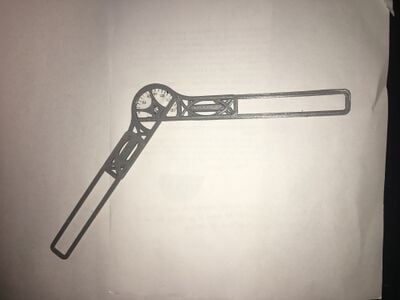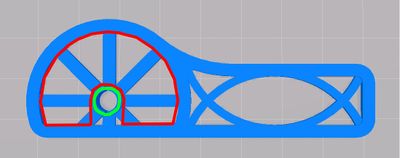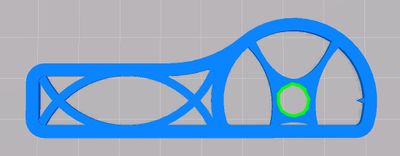| (25 intermediate revisions by the same user not shown) | |||
| Line 9: | Line 9: | ||
==Abstract== | ==Abstract== | ||
Goniometers are simple devices used to measure the angular range of motion of human limbs. It is common for doctors to monitor the muscular recovery and rehabilitation of a patient using a goniometer. They are not expensive, however they are flimsy and break easily. A 3D printed goniometer can be more durable than a commercial one. Additionally, one may not always have a goniometer handy. Being a relatively simple device, a goniometer prints very quickly and cheaply. | |||
Typically, a doctor will use a goniometer to measure the range of motion of a patient. However, with the 3D printed version being so extremely cheap, patients can be provided their own goniometers to monitor their own range of motion, thus reducing expensive doctor's visits. | |||
[[Image:Goniometer3Dprint.jpg|400px|right]] | |||
== Bill of Materials== | == Bill of Materials== | ||
| Line 19: | Line 21: | ||
# Small piece of paper (Cost: Take from recycling/garbage. This should be found for free with no issues) | # Small piece of paper (Cost: Take from recycling/garbage. This should be found for free with no issues) | ||
== Tools | == Tools Needed== | ||
# [[AthenaII| MOST Delta RepRap]] or similar RepRap 3-D printer | # [[AthenaII| MOST Delta RepRap]] or similar RepRap 3-D printer | ||
# Paper | # Paper | ||
| Line 26: | Line 28: | ||
# Protractor | # Protractor | ||
# Scissors | # Scissors | ||
# Glue Stick | |||
== Skills and Knowledge Necessary | == Skills and Knowledge Necessary == | ||
* | * Minor scissor skills to make the paper slip with the angle measurements | ||
== Technical Specifications and Assembly Instructions== | == Technical Specifications and Assembly Instructions== | ||
* Provide directions for print/assembly - be detailed enough in your “how to” to ensure that someone could construct the device from your description. Consider the elegance of IKEA like instructions. | |||
* Include print time estimate | |||
* Include assembly time estimate | |||
* Including drawings or pictures of the device at stage of assembly at minimum. (http://www.appropedia.org/Special:Upload) | |||
====1. Print Parts==== | |||
* Using your 3D printer, print out the attached [https://www.thingiverse.com/thing:4022729 thingiverse] files | |||
* Print 1x gen_base_01.stl, 1x geniometer_spinner_01.stl, 2x goniometer_extend.stl | |||
* Total print time estimate: 40min | |||
'''Print Settings:''' | |||
Resolution: 0.3 mm | |||
Temperature: 205 C | |||
Material: PLA | |||
Print speed: 20mm/s edges, 40 mm/s infill | |||
Infill: 20% | |||
Retraction: ON, Z-hop: ON, Skirt: ON | |||
====2. Paper Slip==== | |||
[[Image:Gon_base_graphic.jpg|400px|right]] | |||
[[Image:Gon_spin_graphic.jpg|400px|right]] | |||
*Using the scissors, cut the small piece of paper to fit inside the rounded portion of the printed part (gen_base_01.stl). This will serve as the angular scale for the goniometer. The paper should fit in the region outlined in red. | |||
*With the protractor, transfer the angle measurements from the protractor in increments on 10 degrees onto the rounded slip of paper cut in step 2. Ensure that the measurements of 0 & 180 degrees line up with the center pivot point of the part. | |||
*Using the glue stick, attach the paper to the radial spokes protruding from the center pivot. The paper should sit below the outer rim of the rounded section. | |||
====3. Snap Together==== | |||
*Snap the printed parts (gen_base_01.stl) and (geniometer_spinner_01.stl) together through the centers of the rounded portions (outlined in green). They should be aligned so that when the handles are pointing in opposite directions, their long straight edges align. | |||
*To make the goniometer longer, take the printed parts (goniometer_extend.stl) and fit their diamond shaped extrusions into the ovular openings on the handles of (gen_base_01.stl) and (geniometer_spinner_01.stl). | |||
=== Common Problems and Solutions=== | === Common Problems and Solutions=== | ||
* | * The male end of the circular snap fitting can turn out poorly if the print speed is too high. I used a maximum of 40 mm/s | ||
== Cost savings== | == Cost savings== | ||
* | |||
* Total print cost of OSAT Goniometer, $0.16 | |||
* Paper/Pencil/Glue costs: Negligible | |||
* Commercial equivalent: [https://www.allegromedical.com/diagnostic-products-c521/360-degree-goniometer-p216696.html?CS_003=9164468&CS_010=8ab281020bb66dff010bb6a0bfce2b23&gclid=EAIaIQobChMIndio9d2f5gIV9ZFbCh0X-gx5EAkYAiABEgIanvD_BwE#SPRI-GON06 $4.19 Goniometer at Allegro Medical] | |||
* Total Savings: $4.03 | |||
* Relative Savings: 96.2% | |||
== Benefited Internet Communities == | == Benefited Internet Communities == | ||
* | * Medecins sans Frontieres [https://www.msf.fr/ msf.fr] | ||
* [https://www.online.physio/ Online Physio] | |||
* [https://www.the-aps.org/?SSO=Y American Physiological Society] | |||
* [https://www.apta.org/ American Physical Therapists Association] | |||
* [https://www.webmd.com/ Webmd] | |||
* [https://www.webpt.com/ Web Physical Therapy] | |||
==References== | ==References== | ||
[[category:OSAT 3D-Printable Designs]] | [[category:OSAT 3D-Printable Designs]] | ||
Revision as of 06:18, 6 December 2019
3D Printable Goniometer
Project developed by Eric Houck, Houcke
Template:Statusboxtop Template:Status-design Template:Status-prototype You can help Appropedia by contributing to the next step in this OSAT's status. Template:Boxbottom
Abstract
Goniometers are simple devices used to measure the angular range of motion of human limbs. It is common for doctors to monitor the muscular recovery and rehabilitation of a patient using a goniometer. They are not expensive, however they are flimsy and break easily. A 3D printed goniometer can be more durable than a commercial one. Additionally, one may not always have a goniometer handy. Being a relatively simple device, a goniometer prints very quickly and cheaply. Typically, a doctor will use a goniometer to measure the range of motion of a patient. However, with the 3D printed version being so extremely cheap, patients can be provided their own goniometers to monitor their own range of motion, thus reducing expensive doctor's visits.

Bill of Materials
Provide a full BOM -- Materials needed for fabrication of device and alternative materials if they are not available, prices/sources of non-printable parts
- Printed parts on Thingiverse https://www.thingiverse.com/thing:4022729 (Cost: 16 cents total filament use)
- Pencil (Cost: <$1.00 to purchase, however they are very common and can be borrowed at no cost)
- Small piece of paper (Cost: Take from recycling/garbage. This should be found for free with no issues)
Tools Needed
- MOST Delta RepRap or similar RepRap 3-D printer
- Paper
- Pencil
- Straightedge
- Protractor
- Scissors
- Glue Stick
Skills and Knowledge Necessary
- Minor scissor skills to make the paper slip with the angle measurements
Technical Specifications and Assembly Instructions
- Provide directions for print/assembly - be detailed enough in your “how to” to ensure that someone could construct the device from your description. Consider the elegance of IKEA like instructions.
- Include print time estimate
- Include assembly time estimate
- Including drawings or pictures of the device at stage of assembly at minimum. (http://www.appropedia.org/Special:Upload)
1. Print Parts
- Using your 3D printer, print out the attached thingiverse files
- Print 1x gen_base_01.stl, 1x geniometer_spinner_01.stl, 2x goniometer_extend.stl
- Total print time estimate: 40min
Print Settings: Resolution: 0.3 mm Temperature: 205 C Material: PLA Print speed: 20mm/s edges, 40 mm/s infill Infill: 20% Retraction: ON, Z-hop: ON, Skirt: ON
2. Paper Slip


- Using the scissors, cut the small piece of paper to fit inside the rounded portion of the printed part (gen_base_01.stl). This will serve as the angular scale for the goniometer. The paper should fit in the region outlined in red.
- With the protractor, transfer the angle measurements from the protractor in increments on 10 degrees onto the rounded slip of paper cut in step 2. Ensure that the measurements of 0 & 180 degrees line up with the center pivot point of the part.
- Using the glue stick, attach the paper to the radial spokes protruding from the center pivot. The paper should sit below the outer rim of the rounded section.
3. Snap Together
- Snap the printed parts (gen_base_01.stl) and (geniometer_spinner_01.stl) together through the centers of the rounded portions (outlined in green). They should be aligned so that when the handles are pointing in opposite directions, their long straight edges align.
- To make the goniometer longer, take the printed parts (goniometer_extend.stl) and fit their diamond shaped extrusions into the ovular openings on the handles of (gen_base_01.stl) and (geniometer_spinner_01.stl).
Common Problems and Solutions
- The male end of the circular snap fitting can turn out poorly if the print speed is too high. I used a maximum of 40 mm/s
Cost savings
- Total print cost of OSAT Goniometer, $0.16
- Paper/Pencil/Glue costs: Negligible
- Commercial equivalent: $4.19 Goniometer at Allegro Medical
- Total Savings: $4.03
- Relative Savings: 96.2%
Benefited Internet Communities
- Medecins sans Frontieres msf.fr
- Online Physio
- American Physiological Society
- American Physical Therapists Association
- Webmd
- Web Physical Therapy